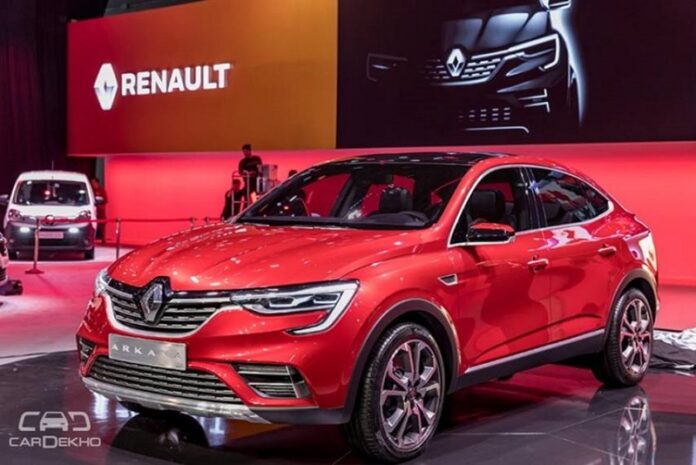
In the automobile industry, the cascading effects are very common. First, the most expensive technologies emerge in higher market segments and then move down the hierarchy of models because R&D costs are already amortized and also because higher volume production helps to recoup the initial investment in that technology. Also in the case of SUV-coupe bodies. We began to see them only in premium brands – BMW X4, Audi Q5 Sportback, Mercedes GLC Coupe – and now they reach the generalists, like this Renault Arkana, which will be the first to democratize the preference for this less orthodox silhouette.
Interestingly, the Arkana was a model produced in Russia for the local market more than two years ago, based on the Dacia Duster and with a global quality that left a little to be desired. Meanwhile, SUV-coupes entered the preferences of general SUV customers, so Renault decided to make a version with Samsung that uses a more evolved platform (CMF-B, which is the basis for cars like the new Renault Clios and Captur ), in South Korea, and thus (from Busan) export the car to Western Europe (at the same time as it has a derivation of Samsung, the XM3 ).
It increased the wheelbase (14 cm more than in the Clio and 8 cm more than in the Captur) and now has more advanced electronics and the same materials and finishes that allowed these two models to make a huge qualitative leap in recent generations. The shape of the bodywork of the Arkana is, therefore, its main distinguishing feature compared to the numerous SUVs of generalist brands that have flooded the market in recent years, with that extension of the fall of the rear pillar. The car ends with a small spoiler that is more visual than functional, as is the case with the second exhaust outlet.
Between The Kadjar And The Koleos
In terms of dimensions, it is located between the Kadjar and the Koleos but we can consider it more crossover than SUV since its height does not exceed 1.57 meters -the new Citroen C4 is only 5 cm less- and the height to the ground is of 19 cm (many SUVs have more). In the driver’s place everything is very familiar to those who know a Captur and also a Clio main elements with an inclination for the driver, mounting with appreciable robustness, soft-touch materials in the upper part of the dashboard (as in the upper areas of the front doors), solid and well-finished ventilation buttons (in metal, as well as the ventilation outlet frames and the door handles, although some details are exclusive to this RS Line version, the most gourmet of the range.
This is the case of the aluminum pedals, the insert with a carbon effect in front of the passenger, the red stitching on the dashboard, steering wheel, transmission selector base, and seat upholstery -which combines velvet and leather- to match the red lines on the bumpers in a context of the assessment of the exterior, also contributed by the metal inserts next to the door sill, bumper and radiator grille. This RS Line version can have the roof in black.
We also have digital instrumentation, available in three different sizes the largest of which -10.2 is the one that mounts the RS Line version. There are two sizes of the central Infotainment screen (7 or 9.3 ), the smallest horizontally and the second vertically. The transmission selector (7-speed automatic, dual-clutch) has a specific shape (in addition to being mounted in a raised position) and does not use any mechanical transmission cable (it only allows to choose between the usual positions P, R, N, and D but it is possible to change gear manually, using the paddles mounted behind the steering wheel). Instrumentation varies in appearance depending on the model selected driving mode ( My Sense is normal, Eco and Sport ) and the Easy Link system allows connectivity with Android and Apple devices.
There is no shortage of storage spaces, from the large pockets in the doors, to the spacious glove compartment and also the area below the transmission selector, where a mobile phone can be charged wirelessly. The space in the rear seats varies between generous height, medium length, and width are limited. That is, with two passengers behind up to 1.85 meters in height, any trip will be pleasant for them, but if there is a third occupant in the center, they will lack space (in addition to the inconvenience caused by the tunnel in the floor next to the feet and because it is a narrower and harder seat than the sides (in the most equipped versions there are a rear armrest and ventilation outlets for this second row).
The luggage compartment has a generous capacity ( 513 liters, again between 472 for the Kadjar and 565 for the Koleos), which can be expanded by folding the seatbacks fully or asymmetrically, but never creating a completely flat cargo area, contrary to what happens with other SUVs in this class. Its shapes are quite usable, but the tailgate line steals height inside the trunk. Such a gate should open wider to avoid possible painful contact with the forehead of a taller user, but that would jeopardize the integrity of the sheet in some garages because there is no remote open/close or proximity sensor on the roof to interrupt the upward movement.
Considering the sporty design of the Arkana, some potential interested in this car may be disappointed with its range of engines. Closer to the end of the year will come the E-Tech (hybrid with the same system as the Clio, which will have a 33-liter smaller boot) and, for now, the 140 hp TCe, which combines the 1 block of gasoline. , 33 liters. with a micro-hybridization system consisting of a small starter motor/alternator associated with a 0.13 kWh and 12V battery (mounted under the passenger seat), which serves to smooth the operation of the stop/start system and allow energy recovery during deceleration ( while the gasoline engine is switched off) and to aid acceleration. Compared to the previous TCe 130 engine, there are 10 hp and 20 Nm more, with a more powerful 160 hp version planned for next fall.
At The Wheel Of The Renault Arkana Tce
With the thick rim steering wheel in hand, I set out for the first few kilometers with the Arkana, to get an idea of its dynamic attributes. With the pleasant elevated driving position, but visibility impaired by the large rear pillars, it immediately becomes apparent that in Eco mode the steering feels too light, gaining a bit of weight and improving the feel in Sport at the same time as the engine response becomes more aggressive.
The downside is that the automatic transmission begins to respond very nervously (the cumulative result of maintaining the same gear until higher revs and making more aggressive downshifts). But in situations where the Arkana TCe 140 is heavily loaded, you can the solution to allow sufficiently agile driving, but always with a lot of effort (even audible) on the part of the engine. The almost 10 seconds it takes from 0 to 100 km / h (and more than half a minute to the starting kilometer) show that this Arkana is much more sporty in its appearance than in its being. In My Sense driving mode, the transmission is smoother and fast enough to shift.
The suspension tuning was clearly done to give the car a lot of stability, outperforming the Kadjar and even the Megane in that regard, at the expense of certain ride comfort on rough asphalt, but which is clearly satisfactory on more regular soils. During this test, which consisted of a mix of highways, national highways, and the city, the average consumption was higher than announced (7.2 instead of 5.8 l / 100 km), despite the benefit promised by the micro hybrid system ( that Renault claims to be 8%). The E-Tech version will use a larger battery (1.2 kWh) that allows the car to run longer with its 1.6 naturally aspirated engine off, which should be reflected in somewhat lower urban consumption, as is the case with the same mounting system. on the Clio.
The prices of the Arkana are not yet defined. We know, however, that it will be about 3,500 euros more expensive than a Captur, in terms of engine and equipment, which places the entry step at 26,500 euros and the RS Line with automatic transmission around 30,000 euros. In any case, it is difficult to understand why there is no hybrid plug-in in Arkana (as there is in the Captur, which is a structurally identical vehicle) that would allow you not only to reduce consumption to really low values but also to complete about fifty kilometers in 100% electric mode, in addition to features more in line with Arkana’s sporty image, especially in this RS Line version. Even if the price increase (already above 35,000 euros) left it close to rivals of premium brands (in non-plug-in versions) whose regular customer Renault has a hard time winning.








